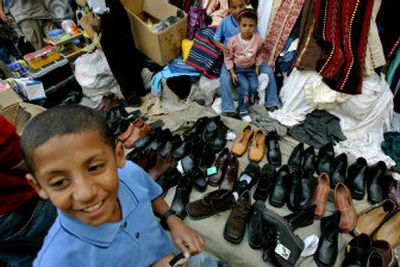No school for Palestinians

RAMALLAH, West Bank – Eighth-grader Thaer Shweikiyeh, who dreams of being a doctor one day, was excited about going back to school after the summer vacation. Instead, he’s been selling onions in the local farmers’ market for the past two months, and his new school bag remains unused.
Thaer is one of 800,000 Palestinian students locked out by an open-ended teachers’ strike, called over the Hamas-led government’s failure to pay salaries to 165,000 civil servants since it came to power in March.
A quick end to the strike appears unlikely.
Squeezed by an international aid boycott, the Islamic militant rulers have no money to pay the teachers. But Hamas says there’s much more behind the walkout than a wage dispute: They accuse the rival Fatah movement, which dominates the teachers’ unions, of keeping the strike going in an effort to bring down the government.
Education Minister Nasser Shaer of Hamas called the strike a “national catastrophe.” He is appealing to the Arab world to help pay the teachers’ salaries. In the meantime, he said, the teachers must return to work.
But educators said they will not keep working for free. “We were left unable to feed our families,” said Muzied Ali, a 47-year-old English teacher at a village high school near Jerusalem.
Many Palestinians put a premium on education as a means of survival – a response to their turbulent history of uprooting and exile. The West Bank and Gaza Strip have one of the highest literacy rates in the Arab world, and Palestinian professionals hold key positions in wealthy Gulf economies, often supporting families back home.
Palestinian parents are increasingly worried about their children’s future as it appears likely students will lose the entire school year due to the standoff – a blow to a society already weary from growing internal strife, economic depression and years of Israeli travel bans.
Most students now spend their days watching TV, hanging out in Internet cafes or pool halls late into the night, or working in their parents’ businesses. Educators fear many 12th-graders may not be able to graduate next spring, even though some teachers are holding informal classes for the seniors.
The exceptions are about 300,000 attending private schools and those funded by the United Nations in refugee camps.
The strike is reminiscent of the Israeli-imposed school closures during the first Palestinian uprising, from 1987-1993, when students would miss months of school at a time. Many of that generation say they still have large gaps in their education they have been unable to fill as adults.
Parents are divided over whether to blame the government or teachers for the current strike.
Bassem Hadaideh, spokesman for the civil servants union, said the strike – which includes some 40,000 teachers and 15,000 health care workers – would be broadened if the government doesn’t pay up.
Some of the 80,000 members of the security forces could soon walk out, he said. The men in uniform are on the job for now, but have staged protests from time to time. One of these protests ignited clashes with Hamas militants that left 12 dead and dozens injured in Gaza this month.
Hamas and Fatah gunmen have tried to settle the strike dispute by force, clashing in West Bank towns over whether schools should be open or closed. Teachers have been threatened by gunmen from both sides.